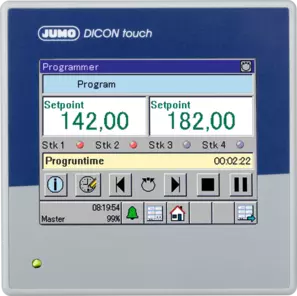
JUMO DICON сенсорный
- Modbus-Master TCP/RTU
- До 4 аналоговых входов
- null














A digital PID controller can be universally programmed and parameterized by an integrated microprocessor. It operates in a proportional, integrating, and differentiating (PID) manner with the intensity of the individual components being adapted to the control process. This is done by dimensioning the control parameters: Xp (proportional band), Tn (reset time), and Tv (derivative time).
The principle of a PID controller is relatively simple to explain. Whether it is a PID temperature controller or a PID humidity controller, the controller always attempts to adjust a specific controlled variable to the setpoint value based on the actual value. In doing so, the P-controller amplifies the control deviation, the I-controller increases its output level in case of an existing control deviation, and the D-controller counteracts the movement of the actual value.
For most applications, the PID structure has the best control behavior. For example, PID compact controllers are very common in the field of temperature control, they also allow direct connection of RTD temperature probes and thermocouples. Some controlled variables require disabling of certain components, including speed and flow.
The P-component reacts very quickly and amplifies the control difference, the I-component eliminates the control deviation, and the D-component counteracts the movement of the actual value.